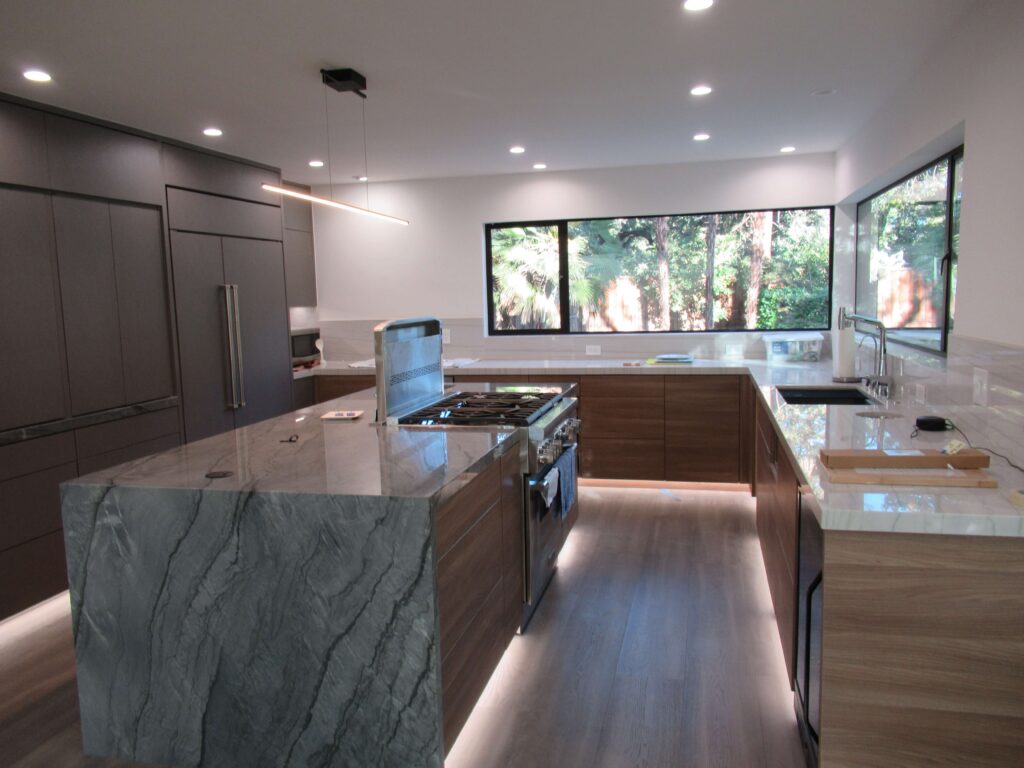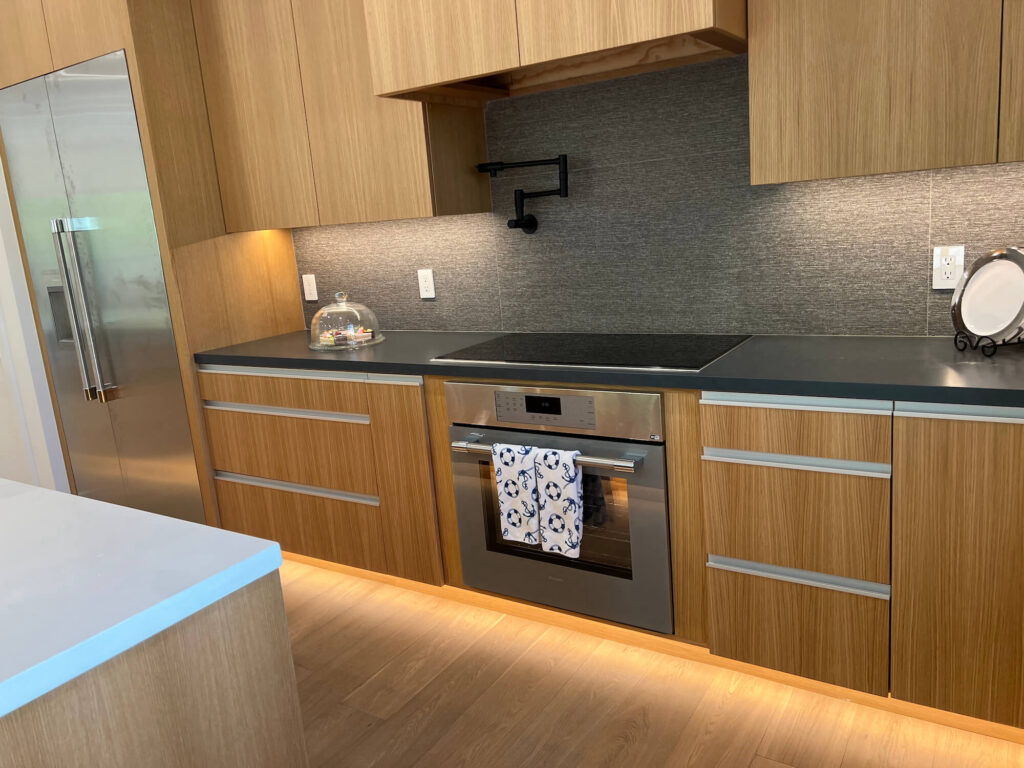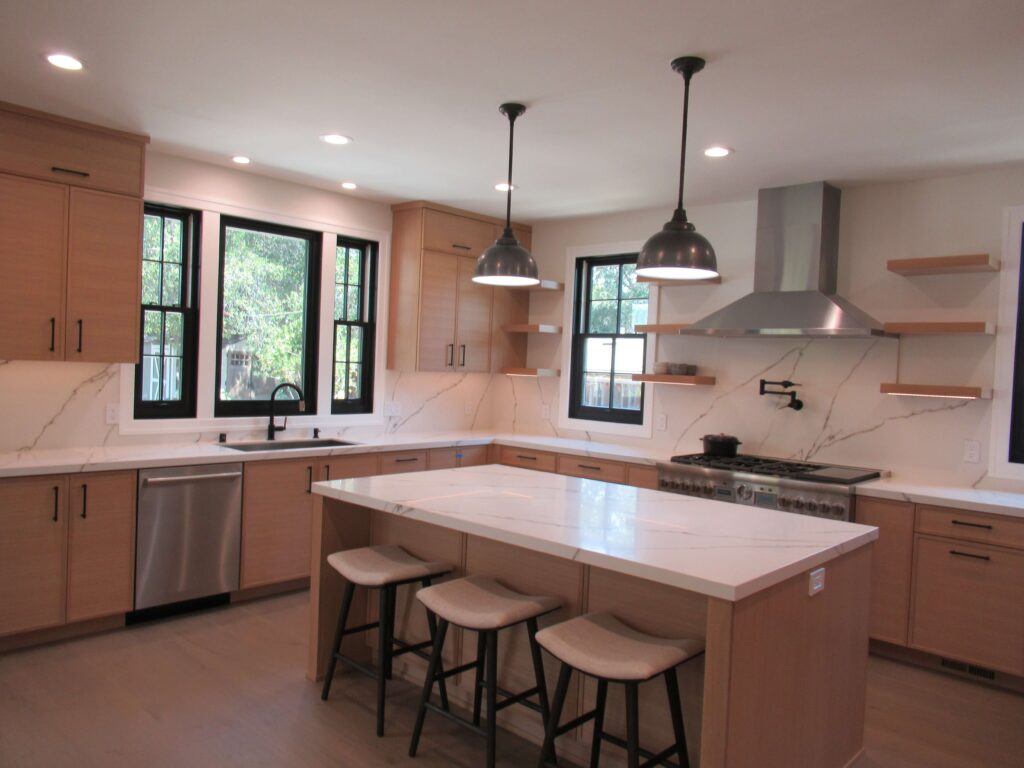Choosing kitchen appliances involves making a myriad of decisions about finish, features, size, style, cost, reliability, and ease of repair. In this article, we offer some recommendations for choosing new appliances.

Kitchen Appliance Finishes
The most popular finishes for kitchen appliances are stainless steel, matte (less shiny than stainless), slate (dark gray), black, and white.
If a uniform look is what you prefer, consider choosing all appliances from the same line of the manufacturer. You might get a “bundle” price by doing this.
If the appliances from one manufacturer do not give you the features you desire, you can mix and match appliances from different manufacturers, but take into consideration possible differences in style, color of the finish, and shape of the handles, and make sure they all work well together.
To make a bold statement, you can choose one unique appliance such as a high-end range or range hood in a material and color different from all the other appliances.
Some high-end appliances such as refrigerators, ovens, and dishwashers are available in styles that will accommodate slide-in panels that match the cabinetry and create an integrated look.
Kitchen Refrigerator
A refrigerator is perhaps the most frequently used appliance in the kitchen. Below are some points to think about as you search for a fridge that will meet your needs and tastes:
- Size – What exterior size will fit in your space? Consider width, depth, and height as well as recommended clearances for air circulation.
- Capacity – How much space do you need for items such as cans, bottles, frozen foods, fresh vegetables, pots of soup, and a whole roast or turkey?
- Location of the Freezer – Do you prefer that the freezer be on the top, side, or bottom?
- Style – Fridges come in many styles: Single Door (one door for fridge and freezer), Double Doors (separate doors for fridge and freezer), Side-by-Side Doors (tall and narrow), French Doors (shorter and wider), and Four Doors.
- Counter-depth – Do you prefer a refrigerator that is less deep than a regular fridge and that aligns with your countertop, creating a uniform look? If so, choose a fridge that is counter-depth.
- Handles – Are the handles integrated or do they protrude? Does the style of the handles complement the style you want to create in your kitchen?
- Noise Rating – Is the refrigerator quiet when it is running and when it is cycling on and off? How much noise do the doors make when you open and close them?
- Energy Star Rating – Does the fridge have energy conservation features?
- Features to Consider:
- Adjustable shelving
- Toughened glass shelves
- A section that is convertible from the refrigerator to the freezer
- Crisper drawer / Independent temperature-controlled bins
- Articulated door hinges that open flush with cabinetry
- State-of-the-art interior illumination
- Precise, adjustable temperature control for the whole fridge
- Dual compressors that keep odors from mingling among compartments
- Dual evaporators that keep humidity constant
- Exterior in-door water dispenser
- Built-in water filter
- Child lock
- Sabbath mode
- Smart-device compatibility
- Panel ready to integrate with your cabinets

Kitchen Range / Cooktop / Oven
The range or cooktop and oven that you choose will probably depend on how often you cook and what kind of cooking you do. Below are some points to consider:
- Dimensions – Determine how much space is available in your kitchen for the range or for a cooktop and oven or ovens.
- Capacity – How large an oven and cooktop do you need? Do you bake frequently? Do you regularly prepare meals for a large family?
- Range – You can choose between Slide-in (fits between cabinets for a finished look) or Free-standing (can stand alone or fit between cabinets).
- Oven – Single or Dual Oven? Wall Oven or Ovens?
- Convection Oven – Convection ovens are popular now. A convection oven has a fan that circulates air around the food for faster cooking. If you value precise temperature control, choose an oven that allows you to turn the fan off and switch between convection baking and regular baking.
- Electric, Gas, Hybrid Cooktop – Local regulations might not allow gas appliances in new construction.
- Induction Cooktop – Induction uses an electromagnetic field to generate heat and allows rapid boil and easy cleanup. (Please note that if anyone in your household has a pacemaker, they are advised to stay at least two feet away from an induction cooktop.)
- Non-Induction Cooktop Smooth Glass or Ceramic Cooktop – These flat surfaces give a kitchen a modern, high-end look and eliminate the hassle of having to remove burners and clean underneath them. Always look for a model with a hot surface indicator and check the manufacturer’s recommendations for what kind of cookware is compatible.
- Number of Burners – Ranges and cooktops come in four, five, and six burner styles as well as four burners with a warmer burner. If you frequently cook for a large family, six burners might be just what you need.
- Controls – Consider style, ease of use, and safety. If you have children or cats who might unintentionally turn controls on or off, look for a “Lock Controls” option.
- Handle – Step back and see if the style of the handle complements the style you want to create in your kitchen.
- Features to Consider:
- Air Fryer – Griddle – Grill
- Steam oven
- Self-clean oven / Steam-clean oven
- Easy-to-clean cooktop
- In-oven camera and sensor
- Storage drawer underneath the range
- Intuitive control panel
- Bright interior lighting
- Sabbath mode
- Energy efficiency
- Smart-device compatibility
Kitchen Dishwasher
Common complaints about dishwashers are noise, long washing times, unsatisfactory drying, and frequent breakdowns, so it pays to read user reviews of the models you are considering. Below are some points to consider:
- Size – How much space is available?
- Capacity – How many place settings will it hold? Is there room for large pots?
- Noise Rating – How noisy is it? Ratings of 41db and lower are the quietest.
- Energy Star Rating – Does it have energy conservation features?
- Length of Wash Cycle – How long does it take to wash and dry dishes?
- Controls – Are the controls attractive (or hidden) and easy to use and clean?
- Handle – Does the style of the handle complement the style you want to create in your kitchen? Is it recessed or does it protrude into the room?
- Possible Features:
- Options for Delayed Start, Quick Wash, Sanitize, and Extra Dry
- Option to wash upper and lower trays independently (Great for water conservation.)
- Third rack for small, thin items
- Adjustable racks
- Soil sensor that adjusts wash time based on soil levels
- Power boost for hard-to-clean items
- Fan-assisted drying technology
- Steel tub (quieter and more durable than plastic)
- Hard water filter / Built-in water softener
- Interior illumination
- Sabbath mode
- Smart-device compatibility
- Panel ready

Kitchen Sink
While a sink is not actually an appliance, it plays a major role in every kitchen. Consider the look, scratch resistance, stain resistance, soundproofing, ease of use, and ease of cleaning. Choose your sink carefully, as the cost to replace it can be high.
- Size – Consider width, length, and depth.
- Capacity – Is there room to drain dishes, rinse vegetables, wash large pots, etc.?
- Noise Rating – Is the sink insulated? Better sinks are made of heavier materials and contain insulation to lessen sound.
- Single Sink or Double Sink – If you prefer a double sink, do you want equal or different sizes and equal or different depths?
- Divider – In a double sink, do you prefer the divider to be sink-height or lower?
- Sink Depth – Is it deep enough to wash large pots but not so deep that users will have to strain to take utensils or small dishes from the bottom? Is it shallow enough that there is room underneath for plumbing and a garbage disposal?
- Undermount or Drop-In (Top Mount) Sink – Undermount sinks have no rim visible on the counter, giving a sleek, modern look and allowing easy cleaning of the countertop. Drop-in sinks used to be popular, but as they prevent easy cleaning of the countertop they have fallen out of favor.
- Farmhouse/Apron Sink – Apron sinks allow sufficient room to wash large items but offer no separate drying room inside. Some apron sinks have a front panel that can be swapped out for another color if you change your kitchen décor.
- Drain Placement in Center or Rear – Right center or rear placement is convenient when scraping dishes and allows placement of plumbing on the right of the cabinet beneath, leaving more space in the center for other items.
- Built-in Ledge – Useful for placement of sink accessories such as cutting board, drying rack, colander, etc.
- Stainless Steel Sink – The most popular kitchen sink material is stainless steel. Look for 16-or 18-gauge stainless. The lower the gauge, the thicker the metal and the lesser the likelihood the sink will scratch, dent, crack and be noisy. The gold standard is type 304 stainless, which is 18/8, at least 50% iron, and corrosion and scratch-resistant. Avoid stainless steel sinks that are coated, as the coating will wear off and the metal underneath is likely to contain impurities and perhaps even harmful alloys.
- Copper Sink – A copper sink will make a bold statement in any kitchen. A sink made of high-quality, cold-rolled, non-recycled, 99.9% pure, 14-gauge copper, with welded (not soldered) seams, can last for centuries. Avoid non-insulated, low-grade, and coated copper sinks, as they can tarnish, rust, crack, and warp.

Kitchen Plumbing Fixtures
Choosing plumbing fixtures that will complement your new appliances can be a pleasurable experience that allows you to express your sense of design. Kitchen Faucets and companion plumbing fixtures such as a Hot Water Dispenser, Cold Water Dispenser, Filtered Water Dispenser, Soap Dispenser, and an Air Gap (a dishwasher runoff that might be required by state plumbing codes) are available in many shapes, sizes, and finishes.
- Finish – Chrome is the most popular finish and the most economical. Other choices include brushed nickel, polished nickel, pewter, brass, bronze, stainless steel, matt black, and custom.
- Faucet Operation – Kitchen faucets are made in several operational styles including Turn-a-Knob, Move-a-Lever (useful as you can operate it with the back of one hand), Touch Activated, or Motion Activated. Visit plumbing fixture showrooms and try out all the styles to see which will work best for you.
- Faucet Type – A new, reliable type has two ceramic discs located inside a cartridge. One disc is stationary and the other moves across to control water flow.
- Integrated Pull Spray Head – Some spray heads don’t pull out or slide back into place easily and sound as if they are in pain. Try out several in a plumbing showroom to find one that moves smoothly and quietly and that has the spray functions that you desire.
Contractor Recommendations:
- Research faucets and other fixtures carefully to confirm ease of use, reliability, ease of repair, cost of repair, etc. It pays to buy the best quality that you can afford.
- Height and Extension of the Faucet – Choose a faucet that is tall enough to allow you to wash tall pots easily and that has a short enough extension so that water lands near the back or middle of the sink rather than splashing on the floor.
- Stainless Steel or Solid Brass construction – Be suspicious if the manufacturer does not disclose the materials. “Brass construction” likely means that the faucet is brass-plated zinc or steel rather than solid brass.
- Choose fixtures with a seamless, one-piece design.
- Choose fixtures with a high-end finish that “pops” and that has a luxurious feel when you touch them.
- Look for a warranty that covers parts and finishes for a lifetime and that does not require submission of the original receipt to obtain replacement parts.
- If you want to install a faucet, hot water or filtered water dispenser, soap dispenser, and air gap on the counter above your sink, decide in advance where you want to have each item installed. Discuss this with your licensed kitchen contractor, as local code, and space available under the counter for a garbage disposal, soap dispenser reservoir, water filter, and other plumbing might dictate the placement.
- If you place a motion-activated soap dispenser (a great item!) next to the faucet, buy top quality (perhaps even commercial quality) and pay attention when you are rinsing vegetables, as you might get a blob of soap in your salad.
Pro Tips for Choosing Kitchen Appliances
- Make a list of “must-have” features for each appliance.
- If you are renovating and wish to change the location of appliances, investigate how that will work with existing plumbing.
- If the finish of an appliance is stainless steel, determine if it is fully clad for durability and for scratch and fingerprint resistance. Fully clad stainless is a nice feature, especially if the appliance will be located where the sun will reflect on it and highlight any smudges.
- When choosing products from different manufacturers, compare the finishes carefully if you want them to be identical, as finishes of the same name (white, chrome, stainless steel, brushed nickel, pewter, etc.) are not always the same shade or sheen.
- When you are choosing major appliances, you can also investigate other kitchen items that you might need or want, such as Range Hood, Microwave, Warming Drawer, Wine Cooler, Garbage Disposal, and Whole-House or Under-sink Water Filter.
- Visit appliance showrooms where you can touch and feel and ask questions about a variety of appliances and then read several user reviews before making your final decisions. With careful research, you can find appliances that will meet your needs and fit your style.
We hope you have found this article useful and informative, and we appreciate the time you took to read it. If you are interested in tips for designing your new kitchen, please see our companion article.
At Bay Area Design & Construction, we would be pleased to assist you in creating the new kitchen or remodeled kitchen of your dreams! You can reach us here – Contact Us
Share this post with your friends!
